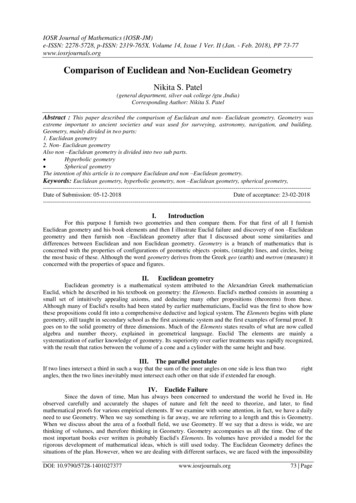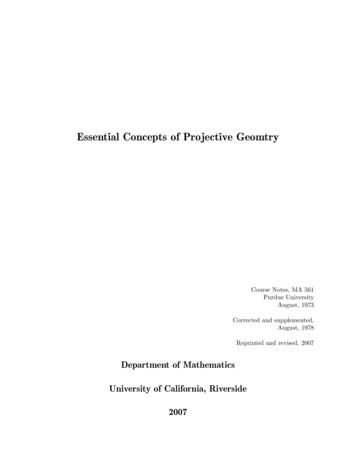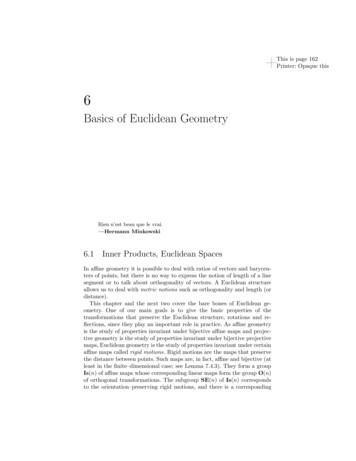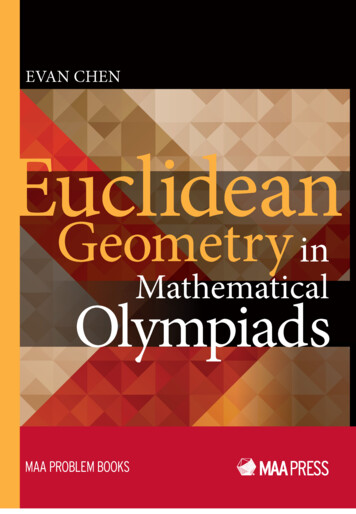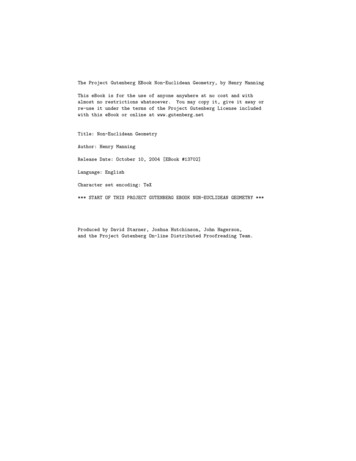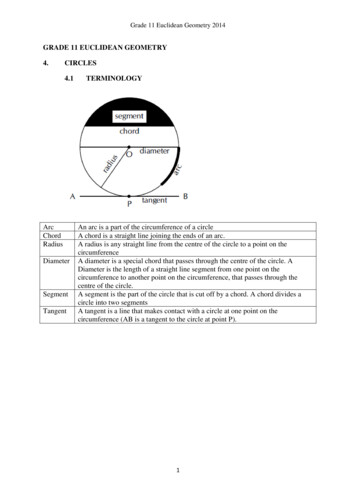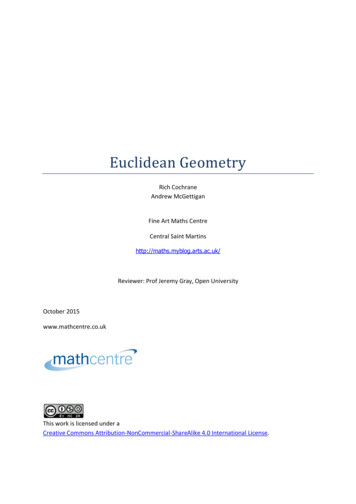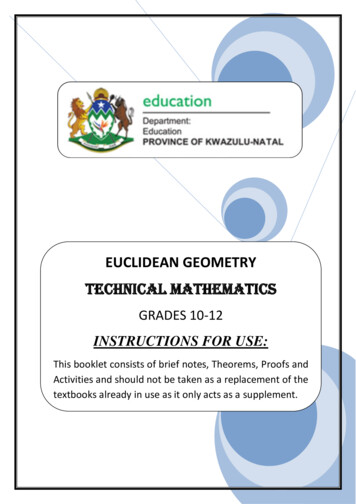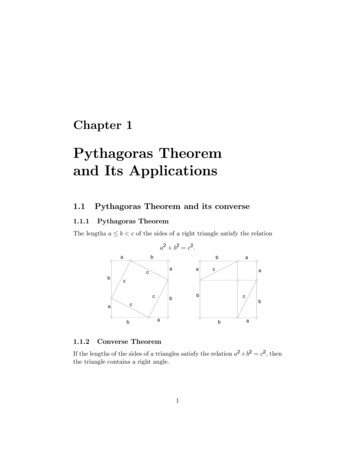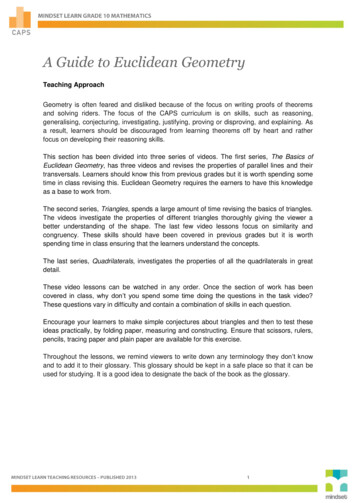
Transcription
A Guide to Euclidean GeometryTeaching ApproachGeometry is often feared and disliked because of the focus on writing proofs of theoremsand solving riders. The focus of the CAPS curriculum is on skills, such as reasoning,generalising, conjecturing, investigating, justifying, proving or disproving, and explaining. Asa result, learners should be discouraged from learning theorems off by heart and ratherfocus on developing their reasoning skills.This section has been divided into three series of videos. The first series, The Basics ofEuclidean Geometry, has three videos and revises the properties of parallel lines and theirtransversals. Learners should know this from previous grades but it is worth spending sometime in class revising this. Euclidean Geometry requires the earners to have this knowledgeas a base to work from.The second series, Triangles, spends a large amount of time revising the basics of triangles.The videos investigate the properties of different triangles thoroughly giving the viewer abetter understanding of the shape. The last few video lessons focus on similarity andcongruency. These skills should have been covered in previous grades but it is worthspending time in class ensuring that the learners understand the concepts.The last series, Quadrilaterals, investigates the properties of all the quadrilaterals in greatdetail.These video lessons can be watched in any order. Once the section of work has beencovered in class, why don’t you spend some time doing the questions in the task video?These questions vary in difficulty and contain a combination of skills in each question.Encourage your learners to make simple conjectures about triangles and then to test theseideas practically, by folding paper, measuring and constructing. Ensure that scissors, rulers,pencils, tracing paper and plain paper are available for this exercise.Throughout the lessons, we remind viewers to write down any terminology they don’t knowand to add it to their glossary. This glossary should be kept in a safe place so that it can beused for studying. It is a good idea to designate the back of the book as the glossary.
Video SummariesSome videos have a ‘PAUSE’ moment, at which point the teacher or learner can choose topause the video and try to answer the question posed or calculate the answer to the problemunder discussion. Once the video starts again, the answer to the question or the rightanswer to the calculation is given.Mindset suggests a number of ways to use the video lessons. These include: Watch or show a lesson as an introduction to a lesson Watch of show a lesson after a lesson, as a summary or as a way of adding in someinteresting real-life applications or practical aspects Design a worksheet or set of questions about one video lesson. Then ask learners towatch a video related to the lesson and to complete the worksheet or questions, either ingroups or individually Worksheets and questions based on video lessons can be used as short assessments orexercises Ask learners to watch a particular video lesson for homework (in the school library or onthe website, depending on how the material is available) as preparation for the next dayslesson; if desired, learners can be given specific questions to answer in preparation forthe next day’s lessonThe Basics of Euclidean Geometry1. What is Euclidean Geometry?This lesson introduces the concept of Euclidean geometry and how it is used in the realworld today. This lesson also traces the history of geometry.2. Revising Lines and AnglesThis lesson is a revision of definitions covered in previous grades. These include linesegment, ray, straight lines, parallel lines and perpendicular lines. The lesson alsoteaches how to recognize and describe pairs of angles formed by perpendicular andparallel lines.3. Angles and Parallel LinesIn this lesson we explore the application of parallel lines and how we can use thisinformation to calculate and find alternate, co-interior and corresponding angels.Triangles1. An Introduction to TrianglesIn this lesson we study the properties of triangles in terms of their sides and angles andclassify them accordingly. We construct, measure and compare the lengths of the sidesand the sizes of the angles.
2. Investigating the Scalene TriangleIn this lesson we revise the properties of a scalene triangle and explore the terminology:Angle bisector, Point of concurrency, Perpendicular bisector, Median and Altitude.3. Investigating the Isosceles TriangleIn this lesson we revise the properties of an isosceles triangle and explore theterminology: Angle bisector, Point of concurrency, Perpendicular bisector, Median andAltitude.4. Investigating the Equilateral TriangleIn this lesson we revise the properties of an equilateral triangle and explore theterminology: Angle bisector, Point of concurrency, Perpendicular bisector, Median andAltitude.5. Theorems of TrianglesThis lesson revises rules and theorems of triangles namely the sum of interior angles ofa triangle and exterior angles of a triangle. We use constructions to learn about andshow these theorems.6. Similar TrianglesIn this lesson we define similarity and identify shapes that are similar, specificallyfocusing on similar triangles. Our approach is to test conjectures by investigating andmeasuring the angles and lines of the shapes. This lesson also links similarity to scaleand ratio.7. Congruent TrianglesIn this lesson we define congruency and identify congruent triangles. We begin byrevising the four conditions that result in congruent triangles. This is done byinvestigating and measuring the angles and lines of the triangles so that learners cansee for themselves.8. The Mid-point TheoremIn this lesson we investigate the line segments joining the midpoints of two sides of atriangle and introduce the new terminology that goes with this theorem. The investigationrequires that learners do the measurements and constructions for themselves.Quadrilaterals1. Revising PolygonsThis lesson revises all the terminology and knowledge covered in previous gradesregarding polygons.2. Investigating the SquareIn this lesson we ask learners to investigate the properties of a square, by reflecting aright angled isosceles triangle twice. Remind learners to fill in all the information on thediagram as they are working through the investigation themselves.
3. Investigating the RhombusIn this lesson we revise the knowledge established so far. You may want to ask learnersto create a rhombus by using two reflections of a right-angled scalene triangle and thendescribe the properties of the rhombus before showing the lesson.4. Investigating the Convex KiteIn this lesson we use an acute-angled scalene triangle and reflect it once to make a kite.We use congruency to prove that the diagonals of a convex kite are perpendicular toeach other and that the vertex angles are bisected by the diagonal.5. Investigating the Concave KiteReflecting an obtuse-angled scalene triangle makes a concave kite. A concave kite hasonly one line of symmetry. Using an obtuse-angled isosceles triangle can also make aconcave kite.6. Investigating the RectangleThis lesson begins by investigating whether we can make a rectangle by reflection of aright angled scalene triangle, and we find that only rotation can produce a rectangle. Wesee that rotation always occurs around a fixed point; in this case, it must be the midpointof the hypotenuse.7. Investigating the ParallelogramIn this lesson we rotate an obtuse-angled scalene triangle to make a parallelogram. Aswith convex kites, we use congruent triangles to prove the properties of the diagonals.8. Investigating the TrapeziumIn this lesson, we create a trapezium by reflecting an isosceles right-angled triangletwice. We discover that the only properties of a trapezium are that one pair of oppositesides is parallel and the co-interior angles are supplementary.9. Comparing all QuadrilateralsIn this lesson we review all the quadrilaterals we have done in this series. We use a quizto consolidate the properties of quadrilaterals. This also gives learners a chance tocompare the properties of these shapes with each other.
Resource MaterialThe Basics of Euclidean Geometry1. What is EuclideanGeometry?2. Revising Lines andAngles3. Angles and ol.com/EZSheets/Geometry/Lines ar8/ch09 geometry/03 parallel/lines.htmThis website defines Euclidean Geometry.This website explains the concepts parallel linesand pairs of angles.This is a premier educational portal thatprovidesstudentswithresourcesonMathematics from counting by using objects tomultiplication.This website looks at angles associated withparallel linesTriangles1. An Introduction dy-help-geometrytriangles/2. Investigating theScalene Trianglehttp://www.mathopenref.com/scalene.html3. Investigating theIsosceles his website provides students with studyguides which have explanation, exampleproblems, and practice problems with solutionsto help you learn triangles for geometry.This is an all in one package on scalenetriangles that defines scalene triangles andprovides facts about them.This website provides information on isoscelestriangles.4. Investigating theEquilateral lThis is a great website to get the basics onequilateral triangles5. Theorems try/11geometry-04.cnxmlplusThis website gives a brief overview on theoremsof triangles6. Similar Triangles7. CongruentTriangles8. The Mid-pointTheoremRefer to this website to learn more about whentriangles are considered similar.This website is a test and worksheet generatorfor Math teachers.This website defines when a triangle isconsidered congruent.This is a test and worksheet generator for MathteachersA chapter from Everything Maths textbook onthe midpoint theorem:
Quadrilaterals1. Revising Polygons2. Investigating theSquare3. Investigating theRhombus4. Investigating theConvex Kite5. Investigating theConcave Kite6. Investigating theRectangle7. Investigating theParallelogram8. Investigating theTrapezium9. Comparing tp://www.mathsisfun.com/geometry/rhombus.htmlA useful site to explore df-d296283022Learn about convex kites here.Learn about all the different types of polygonson this site.Learn more about squares on this site.For everything there is to know about rhombusrefer to this site.This website provides a fun and interactive wayof learning about the concave kiteThis website provides an overview onrectangles.This website provides a fun and interactive wayof learning about parallelogramsNote on the properties of a trapezoid:Test your knowledge on quadrilaterals on thiswebsite.Here you will find a blank quadrilateral flowchart where you can take notes.
TaskQuestion 1Solve for the unknown angles.1.1.1.2.1.3.Question 2State with reasons whether each triangle is similar or congruent.2.1.2.2.
Question 3Given that the following triangle are similar, determine the values of x and yQuestion 4 ABC is similar to DEF. CalculateQuestion 5Prove that triangle ABC is congruent to triangle DCBQuestion 6Prove that triangle ABD is congruent to triangle CBE
Question 7Prove that quadrilateral ABCD is a parallelogramQuestion 8Given are two circles that intersect at P and R. S and Q are centres of the respective circles.Prove that PQRS is a kite.Question 9PQRS is a rhombus with its diagonals intersecting at T. TV TQ and TU QU. Prove thatTUQV is a rhombus.
Question 10In ABC points D and E are midpoints of AB and ACrespectively.BC 34mm EDC is 390 DEB is 320.Using the given information, determine the values of , β and θQuestion 11In ABC, F and E are the midpoints of AB and AC respectively. ED 2FE. Prove thatBCDE is a parallelogram.
Task AnswersQuestion 11.1.Vert. opp angles are equalAdj. angles on a straight line1.2.Corresponding angles are equal AB//CDVertical opp. angles are equal1.3.Vert. opp. angles are equalSum of angles in a triangleQuestion 22.1.̂̂̂̂̂ Given̂̂̂sum of angles in a trianglesum of angles in a triangle2.2.GivenQuestion 33.1.ABC III PQRABC III PQR3.2.
Question 44.1In ABC and BCD̂ ̂ GivenAB DC GivenBC BC CommonRHS4.2In ABD and CBEAB BC Given̂̂ Isosceles triangle base angles equalBE EC Given̂ ̂ Isosceles triangleBD AD Given̂ ̂ Isosceles trianglê ̂̂ ̂SAAQuestion 5Note: There are two parts to this proof. Since AB is given as being parallel to CD it remains to beproven that it is equal as well. To do that it is helpful to show that ABE CEDDE EB GivenE1 E3 Vert. opp. angles are equalB1 D1 Alt. angles are equal, AB//DC CED SAAAB DCABCD is a parm, one pair of sides are equal and parallel.Question 6SP SRRadiiPQ QRRadiiPQRS is a kite Two pairs of adjacent sides are equal.Question 7Note: In order to prove that QUTV is a rhombus, it is necessary to prove that it’s a parallelogram withequal adjacent sides.̂̂Diagonals of rhombus PQRS bisect angleŝ̂Isosceles triangle base angles are equal̂̂Isosceles triangle base angles are equalQU QV and VT UTQV//UT and QU//VTis a rhombus Parm with adjacent sides equal
Question 8DE BCMidpoint TheoremMidpoint Theoremalt angle equal DE//BCalt angle equal DE//BCQuestion 9AF FB and AE ECFE//BC and BC 2FEGivenMidpt theoremED 2FEED BCBCDE is a parmGivenPair of opp. sides are equal and parallel.Question 10StatementReasonAD DB and AE ECGiven D and E are mid pts.DE BCMid pt TheoremDE DE II BCMid pt TheoremAlt angles, DE II BCAlt angles, DE II BCQuestion 11StatementReasonAF FB and AE ECGiven F and E are mid pts.BC 2FEMid pt TheoremED 2FEGivenBC EDFE II BCMid pt TheoremFD II BCBCDE is a parmOpp. Sides equal and parallel
AcknowledgementsMindset Learn Executive HeadContent Manager Classroom ResourcesContent Coordinator Classroom ResourcesContent AdministratorContent DeveloperContent ReviewerDylan BusaJenny LamontHelen RobertsonAgness MunthaliRaquel de FreitasGhairoeniesa JacobsProduced for Mindset Learn by TrafficFacilities CoordinatorProduction ManagerDirectorEditorPresenterStudio CrewGraphicsCezanne ScheepersBelinda RenneyAlriette GibbsNonhlanhla NxumaloTumelo MalokaLebo MazibukoAbram TjaleJames TselapediWayne SandersonJenny van der LeijThis resource is licensed under a Attribution-Share Alike 2.5 South Africa licence. When using thisresource please attribute Mindset as indicated athttp://www.mindset.co.za/creativecommons
A Guide to Euclidean Geometry Teaching Approach Geometry is often feared and disliked because of the focus on writing proofs of theorems and solving riders. The focus of the CAPS curriculum is on skills, such as reasoning, generalising, conjecturing, investigati
